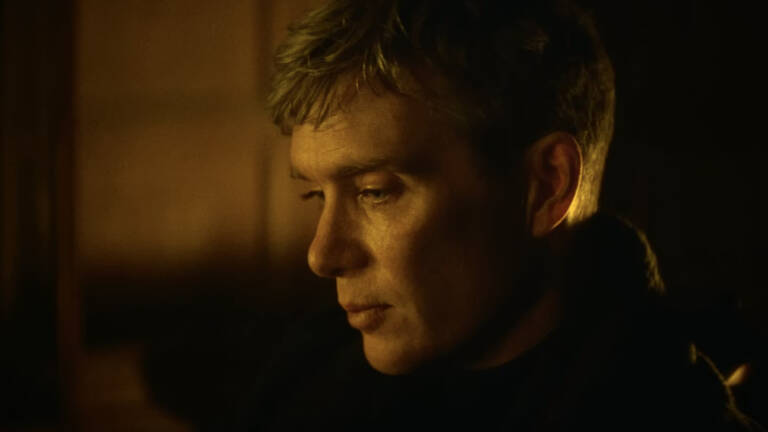
Dir. Jafar Panahi, Iran, 2015, 82 mins, in Persian with subtitles
Cast: Jafar Panahi, Hana Saeidi
A measured, thoughtful and modest production, the film largely features Panahi alongside friends, family and strangers who make a number of journeys within Panahi’s cab (Panahi masquerades as a taxi driver). However, it becomes quickly clear that Panahi is infinitely more interested in the multitude of opinions of his passengers as what initially appears to be mindless chatter carries with it serious cultural implications.
Winner of the 2015 Golden Bear at the Berlin International Film Festival, the documentary aesthetic serves Taxi Tehran well, being largely indicative of the restrictions Panahi is under. Throughout he makes little attempt to hide his attempt at surveillance, the mini-cam in the front of Panahi’s cab being his primary mode of recording. This self-reflexive mode of reference transforms traditionally ordinary candid moments, creating an amazing sense of authenticity and personality to a film that strives to do so much.
Taxi Tehran can be placed under the same banner as his previous films, This is Not a Film (2011) and Closed Curtain (2013), being produced during the lengthy 20-year filmmaking ban imposed upon him by the Iranian government in late-2010. Unlike his previous films which were shot with extreme secrecy in the privacy of enclosed quarters, Panahi takes more risks by moving his film to a larger locale and by involving many more people.
Perhaps then Taxi Tehran can be seen as the ultimate declaring of love for the filmmaking medium as well as that for the people of his country and the country itself as he continues to work and pay huge attentions to the very same people who unfairly banned him from creativity. Here a discussion of the film title seems relevant, Tehran being Iran’s capital city as well as the single locale in which the film is exclusively filmed, a direct effect of the continued geographic restrictions in which he is unable to travel outside Tehran.
As the cab nonchalantly drives through the streets so familiar to Panahi, his attention turns to the plight of many, selflessly making the decision to not include his own struggles between himself and the Iranian government in recent years.
In this way Panahi remains sensitive to the plight of his fellow countrymen as a myriad of issues relating to government surveillance, robbery, poverty, homelessness, film piracy and misogyny become the topics of conversation within Panahi’s film.
Throughout there are star turns from a number of the cab’s passengers, not least Panahi’s young niece Hana Saeidi, a sharp-witted and ferocious film enthusiast who in a very similar fashion to her uncle records every moment of their conversation on a handheld digital camera, some of her footage then being assimilated into Panahi’s film giving it a welcomed fresh perspective.
Similarly, human rights lawyer Nasrin Sotoudeh provides an important sequence of dialogue as the long-time friend of Panahi, and the cab’s final passenger. Talking about the perils of government surveillance which she argued “make[s] your life an entire prison… turning the outside world into a bigger prison, and your friends into your worst enemies. After that you think that all you can do is either leave the country, or pray to return to that hole.” Whether or not this is in reference to Panahi’s personal situation she is very much in keeping with the wide-ranging political commentary Panahi imposes upon his audience. Endearingly referred to as the ‘lovely flower lady’ by Hana, her beautifully eloquently speech sparks probably the film’s most sincere sequence that perfectly encapsulates the situation Panahi currently finds himself in.
The film remains thought provoking throughout, from discussion of ‘lurid reality’ in Iranian film culture, the issues of restricted film consumerism still present within the country, to the entire discussion of the absurdity that a criminal can still be executed for petty theft, and women for attending a volleyball match unaccompanied; through all this the premise of Taxi Tehran remains simple; an open dialogue free from political repercussion.
Despite the fact that some sequences work better than others, this should not stand as an overall detraction. It is easy to see the points Panahi is trying to illustrate throughout, and his efforts must be praised as it quickly becomes impossible to remain unmoved by the feeling that Panahi creates. In every film Panahi continues to make under his ban he continues to prove the point that human spirit will prevail and endure. Despite a number of sequences that beg the question of spontaneity versus staging, it should here be noted that Taxi Tehran is in no way artistically groundbreaking, but makes a big statement in a country where personal freedoms continue to remain heavily restricted by strict governmental and religious laws.
There are no end titles in Taxi Tehran, caution being on the side of attributors who remain anonymous for fear over their safety following the release. If this is not the biggest example of the extreme environmental pressures Panahi continues to work under than make what you will of the film’s final sequence which is shrouded in mystery.
Only time will tell if Panahi can and will continue to be able to make films in this way or by any other method, but if this latest effort is anything to go by audiences should be excited for what comes next using more creative methods.
Review by Rayvenn Shaleigha D’Clark
Taxi Tehran is out on DVD on 22 February.







